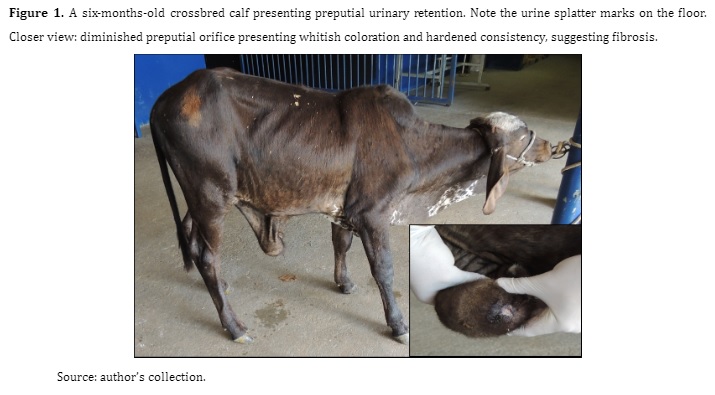Case report of surgical correction of acquired preputial stenosis in a calf
DOI :
https://doi.org/10.21708/avb.2024.18.1.12016Résumé
Diseases involving the reproductive tract of male ruminants, especially bulls, are a significant cause of economic and genetic loss to beef and dairy cattle industry worldwide. In calves, congenital hypospadia is the most commonly reported condition affecting genital organs. In the reviewed literature, there are no reports of surgical correction of acquired phimosis in calves. Therefore, the present paper aimed to report the surgical correction by circumcision of a traumatic-induced phimosis in a calf. A 6-months-old crossbred calf was submitted to surgical correction of acquired preputial stenosis by the Lazzeri circumcision approach. Surgery was uneventful and post-operatory complication was restricted to partial wound dehiscence, that did not compromise complete secondary intention healing. Long-term follow-up (30-months after surgery) was conducted by telephone call, revealing that the calf is now a bull with 3-years-old and still is the herd’s breeder. To the best of our knowledge, this is the first report of surgical correction by circumcision of a traumatic-induced phimosis in a calf using the Lazzeri technique. In this calf post-operatory complications were considered minor and long-term follow-up confirmed that the procedure was successful, and the animal obtained its reproductive capacity maintained.
Téléchargements

Téléchargements
Publié-e
Numéro
Rubrique
Licence
(c) Tous droits réservés Acta Veterinaria Brasilica 2024

Cette œuvre est sous licence Creative Commons Attribution 4.0 International.
Autores que publicam na Acta Veterinaria Brasilica concordam com os seguintes termos: a) Autores mantém os direitos autorais e concedem à revista o direito de primeira publicação, com o trabalho simultaneamente licenciado sob a Licença Creative Commons Attribution que permite o compartilhamento do trabalho com reconhecimento da autoria e publicação inicial nesta revista. b) Autores têm autorização para assumir contratos adicionais separadamente, para distribuição não-exclusiva da versão do trabalho publicada nesta revista (ex.: publicar em repositório institucional ou como capítulo de livro), com reconhecimento de autoria e publicação inicial nesta revista. c) Autores têm permissão e são estimulados a publicar e distribuir seu trabalho online (ex.: em repositórios institucionais ou na sua página pessoal) a qualquer ponto antes ou durante o processo editorial, já que isso pode gerar alterações produtivas, bem como aumentar o impacto e a citação do trabalho publicado (Veja O Efeito do Acesso Livre).


 Esta obra está licenciada com uma Licença
Esta obra está licenciada com uma Licença 